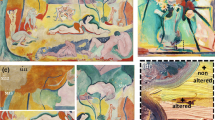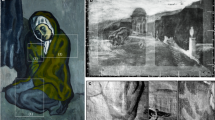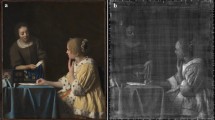Abstract
The blue pigment smalt, a synthetic potash glass tinted with cobalt, was widely used between the sixteenth and the eighteenth centuries. As part of a study on the alteration of smalt and the reconstitution of its original color, the painting: Woman doing a Libation or Artemisia (Fontainebleau school, 1570) was examined in which the artist used smalt as a blue pigment, which is now degraded. Noninvasive imaging was performed using macro-2D X-ray fluorescence and reflectance imaging spectroscopy to get an overview of the artist’s palette and its distribution. Samples prepared as cross sections were also analyzed by scanning electron microscopy coupled with energy dispersive spectroscopy, micro-X-ray absorption near-edge structure spectroscopy and synchrotron micro-X-ray diffraction imaging to determine the preservation state of the smalt as well as structural information on other pigments adjacent to smalt grains in individual paint layers, which could play a role in the degradation process. On the one hand, the study conducted on the alteration of smalt has shown that it is very weathered and mixed with hydrocerussite, which could be a factor that would facilitate the alteration. On the other hand, these analyses have made it possible to identify and locate the pigments used, which will be the basis for the virtual reconstruction of the color of the painting.







Similar content being viewed by others
Data Availability Statement
This manuscript has associated data in a data repository of the ESRF. The 2D-\(\upmu\)XRD datasets generated during and analyzed during the current study are available in the ESRF repository: DOI 10.15151/ESRF-ES-527799901. All the other datasets generated during and/or analyzed during the current study are available from the corresponding author on reasonable request.
References
A. Genty-Vincent, T.P. Van Song, C. Andraud et al., Four-flux model of the light scattering in porous varnish and paint layers: towards understanding the visual appearance of altered blanched easel oil paintings. Appl. Phys. A 123, 473 (2017). https://doi.org/10.1007/s00339-017-1092-1
L. Monico, K. Janssens, E. Hendriks, F. Vanmeert, G. Van der Snickt, M. Cotte, G. Falkenberg, B. Brunetti, C. Miliani, Evidence for degradation of the chrome yellows in van Gogh’s sunflowers: a study using noninvasive in situ methods and synchrotron-radiation-based X-ray techniques. Angew. Chem. 54, 14129–14133 (2015). https://doi.org/10.1002/anie.201505840
F. Delamare, Aux origines des bleus de cobalt: les débuts de la fabrication du saffre et du smalt en europe occidentale. Comptes-rendus des séances de l année - Académie des inscriptions et belles-lettres 153(1), 297–315 (2009). https://doi.org/10.3406/crai.2009.92472
H. Stege, Out of the blue ? Zeitschrift für Kunsttechnologie: ZKK 18(1), 121–142
B. Mühlethaler, J. Thissen, SMALT. Studies in Conservation 14(2), 47–61. https://doi.org/10.1179/sic.1969.005. Accessed 2022-07-26
M. Spring, C. Higgitt, D. Saunders, Investigation of pigment-medium interaction processes in oil paint containing degraded smalt. Natl. Gallery Tech. Bull. 26, 56–70 (2005)
J. Hartwig, De la fabrication et de l’utilisation du safre ou zaffera (cobalt) et du smalte , par les verriers durant les XVI ème,XVII ème et XVIII ème siècles. Verre 7
M. van Eikema Hommes, Changing pictures : discoloration in 15th-17th-century oil paintings. In: Changing Pictures, pp. 17–50. Archetype, London (2004)
L. Robinet, M. Spring, S. Pagès-Camagna, Vibrational spectroscopy correlated with elemental analysis for the investigation of smalt pigment and its alteration in paintings. Anal. Methods 5(18), 4628 (2013). https://doi.org/10.1039/c3ay40906f
I. Reiche, C. de Mecquenem, M. Eveno, L’utilisation du smalt et son altération dans les peintures des collections françaises. Les bleus et les verts: couleurs et lumières. eds. M. Menu, A-S. Le Hô, eds. Herman, p. 75–88 (2022)
I. Reiche, M. Eveno, C. de Mecquenem, T. Calligaro, E. Laval, R. Pillay, E. Ravaud, V. Etgens, K. Mösl, M. Alfeld, The original appearance and beauty of ancient paintings virtually reconstructed. Fundation for Heritage Science, Heritage for the Future, Science for Heritage, Symposium proceedings, 164–170 (2022)
V. Gonzalez, T. Calligaro, G. Wallez, M. Eveno, K. Toussaint, M. Menu, Composition and microstructure of the lead white pigment in masters paintings using HR synchrotron XRD. Microchem. J. 125, 43–49 (2016). https://doi.org/10.1016/j.microc.2015.11.005
M. Alfeld, J.A.C. Broekaert, Mobile depth profiling and sub-surface imaging techniques for historical paintings-a review. Spectrochim. Acta, Part B 88, 211–230 (2013). https://doi.org/10.1016/j.sab.2013.07.009
M. Eveno, E. Ravaud, T. Calligaro, L. Pichon, E. Laval, The Louvre crucifix by Giotto—unveiling the original decoration by 2D-XRF, X-ray radiography, emissiography and SEM-EDX analysis. Herit. Sci. 2, 17 (2014). https://doi.org/10.1186/s40494-014-0017-y
V.A. Solé, E. Papillon, M. Cotte, P. Walter, J. Susini, A multiplatform code for the analysis of energy-dispersive X-ray fluorescence spectra. Spectrochim. Acta, Part B 62, 63–68 (2007)
R. Pillay, J.Y. Hardeberg, S. George, Hyperspectral imaging of art: acquisition and calibration workflows. J. Am. Inst. Conserv. 58(1–2), 3–15 (2019). https://doi.org/10.1080/01971360.2018.1549919
C. Riekel, M. Burghammer, R. Davies, Progress in micro- and nano-diffraction at the ESRF ID13 beamline. IOP Conf. Series: Mater. Sci. Eng. 14, 012013 (2010). https://doi.org/10.1088/1757-899X/14/1/012013
M. Cotte, V. Gonzalez, F. Vanmeert, L. Monico, C. Dejoie, M. Burghammer, L. Huder, W. de Nolf, S. Fisher, I. Fazlic, C. Chauffeton, G. Wallez, N. Jiménez, F. Albert-Tortosa, N. Salvadó, E. Possenti, C. Colombo, M. Ghirardello, D. Comelli, E. Avranovich Clerici, R. Vivani, A. Romani, C. Costantino, K. Janssens, Y. Taniguchi, J. McCarthy, H. Reichert, J. Susini, The “historical materials bag”: A new facilitated access to synchrotron x-ray diffraction analyses for cultural heritage materials at the european synchrotron radiation facility. Molecules 27(6) (2022). https://doi.org/10.3390/molecules27061997
L. Robinet, M. Spring, S. Pagés-Camagna, D. Vantelon, N. Trcera, Investigation of the discoloration of smalt pigment in historic paintings by micro-x-ray absorption spectroscopy at the co k-edge. Anal. Chem. 83(13), 5145–52 (2011)
V. Gonzalez, Caractérisation micro-structurale et luminescence des carbonates de plomb: apport à la discrimination des pigments blancs de plomb des œuvres peintes. PhD thesis (2016)
E. Welcomme, Développement de techniques combinées de microanalyse par rayonnement synchrotron pour l’étude des pigments à base de carbonates de plomb. PhD thesis (2007)
V. Gonzalez, T. Calligaro, G. Wallez, M. Eveno, K. Toussaint, M. Menu, Composition and microstructure of the lead white pigment in masters paintings using HR synchrotron XRD. Microchem. J. 125, 43–49 (2016). https://doi.org/10.1016/j.microc.2015.11.005
P. Taylor, V.J. Lopata, Stability and solubility relationships between some solids in the system PbO-CO2-H2O. Can. J. Chem. 62(3), 395–402 (1984)
Acknowledgements
This work was supported by the University School of Humanities, Creation, Heritage, Investment of Future ANR-17- EURE-0021 - Fondation des Sciences du Patrimoine through the MARCS project. We would like to thank the SOLEIL synchrotron facility for providing beamtime through the in house proposal 99200118 as well as Sebastian Schoeder and Laurent Tranchant for the help during beamtime at the PUMA beamline. We would also like to thank the European Synchrotron Research Facility (ESRF) for providing beamtime through the Historical Materials BAG (HG172) as well as Manfred Burghammer for the help brought for the use of the beamline ID13 and Marine Cotte, Victor Gonzales, Frederik Vanmeert and Letizia Monico, responsible scientists of the Historical Materials BAG for their support of the programme. Finally, we thank Cécile Scallierez, curator at the Louvre museum and Isabelle Chochod, restorer of the painting, for allowing us study the artwork together and for the fruitful discussions.
Author information
Authors and Affiliations
Corresponding author
Additional information
Focus Point on Scientific Research in Cultural Heritage 2022 Guest editors: L. Bellot-Gurlet, D. Bersani, A.-S. Le Hô, D. Neff, L. Robinet, A. Tournié.
Rights and permissions
Springer Nature or its licensor (e.g. a society or other partner) holds exclusive rights to this article under a publishing agreement with the author(s) or other rightsholder(s); author self-archiving of the accepted manuscript version of this article is solely governed by the terms of such publishing agreement and applicable law.
About this article
Cite this article
de Mecquenem, C., Eveno, M., Alfeld, M. et al. A multimodal study of smalt preservation and degradation on the painting “Woman doing a Libation or Artemisia” from an anonymous painter of the Fontainebleau School. Eur. Phys. J. Plus 138, 185 (2023). https://doi.org/10.1140/epjp/s13360-023-03799-4
Received:
Accepted:
Published:
DOI: https://doi.org/10.1140/epjp/s13360-023-03799-4




